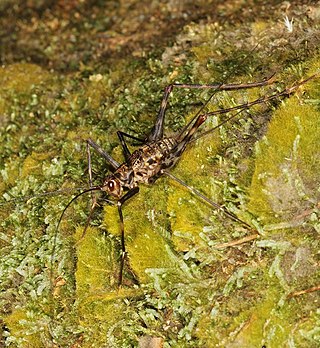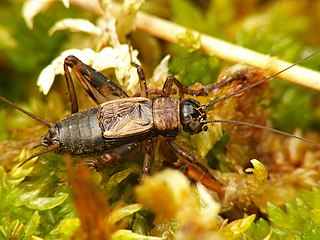
Anostostomatidae is a family of insects in the order Orthoptera, widely distributed in the southern hemisphere. It is named Mimnermidae or Henicidae in some taxonomies, and common names include king crickets in Australia and South Africa, and wētā in New Zealand. Prominent members include the Parktown prawn of South Africa, and the giant wētā of New Zealand. The distribution of this family reflects a common ancestry before the fragmenting of Gondwana.

Cooloola is a genus of ensiferan orthopterans known as Cooloola monsters. It is the only genus in the subfamily Cooloolinae and family Cooloolidae of the superfamily Stenopelmatoidea.

Ensifera is a suborder of insects that includes the various types of crickets and their allies including: true crickets, camel crickets, bush crickets or katydids, grigs, weta and Cooloola monsters. This and the suborder Caelifera make up the order Orthoptera. Ensifera is believed to be a more ancient group than Caelifera, with its origins in the Carboniferous period, the split having occurred at the end of the Permian period. Unlike the Caelifera, the Ensifera contain numerous members that are partially carnivorous, feeding on other insects, as well as plants.

Bandwings, or band-winged grasshoppers, are the subfamily Oedipodinae of grasshoppers classified under the family Acrididae. They have a worldwide distribution and were originally elevated to full family status as the Oedipodidae. Many species primarily inhabit xeric weedy fields, and some are considered to be important locusts:

Aglaothorax is a genus of ovate shieldbacks in the family Tettigoniidae. There are about six described species in Aglaothorax.
Conozoa hyalina, the California Central Valley grasshopper or just Central Valley grasshopper, was a species of grasshopper in the family Acrididae, now extinct. It was endemic to the United States.

Trimerotropis is a genus of band-winged grasshoppers in the family Acrididae. There are at least 50 described species in Trimerotropis.

Gryllus is a genus of field cricket. Members of the genus are typically 15–31 mm long and darkly coloured. The type species is Gryllus campestris L.: the European field cricket.

Phalangopsinae, occasionally known as spider crickets, are a subfamily of crickets in the family Phalangopsidae. Members of Phalangopsinae are found worldwide in tropical and subtropical regions. Most species in the subfamily are nocturnal and can be found in rocky areas, near fallen wood, and the understory of forests. Some species are gregarious, gathering in large numbers.

Nemobiinae is a subfamily of the newly constituted Trigonidiidae, one of the cricket families. The type genus is Nemobius, which includes the wood cricket, but members of this subfamily may also be known as ground crickets or "pygmy field crickets".

Agraeciini is a large tribe of bush crickets or katydids in the conehead subfamily, Conocephalinae.

Trimerotropini is a tribe of band-winged grasshoppers in the family Acrididae. There are at least 70 described species in Trimerotropini: found in the western Americas.
Morsea is a genus of monkey grasshoppers in the family Eumastacidae. There are about seven described species in Morsea.

Pseudosermyle is a genus of walkingsticks in the family Diapheromeridae. There are more than 20 described species in Pseudosermyle.
Aglaothorax diminutiva, the diminutive shieldback, is a species of shield-backed katydid in the family Tettigoniidae. It is found in North America.
Conozoa clementina, the San Clemente grasshopper, is a species of band-winged grasshopper in the family Acrididae. It is found in North America.
Cnemotettix is a genus of silk-spinning crickets in the family Anostostomatidae. There are about five described species in Cnemotettix.

Podoscirtinae is a subfamily of crickets in the family Gryllidae.

Aglaothorax morsei, commonly known as Morse's shieldback, is a species of shield-backed katydid in the family Tettigoniidae. It is found in North America.
Anabropsini is a tribe of king crickets. The tribe comprises over 40 species, has a broad distribution in Old and New World tropics, including Asia, Africa, Oceania, Central America, and South America.













